Combat Reforged
Weapons are a vital part of the D&D experience that martial characters depend on as their primary source of damage. However, in 5e they have been left woefully underdeveloped. In this document, I will outline changes and additions that bring new life to the martial side of adventuring.
Critical hits are now more impactful, providing more interesting rewards for rolling a 20. Also, weapons now carry a new property called weapon arts, which creates unique playstyles for weapons that previously had very similar or identical properties.
Table of Contents
-
Critical Hits
-
Weapon Arts
- 3Backbreaker
- 3Cleave
- 3Concussive Smash
- 3Crippling Strike
- 3Flourish
- 3Gargantuan Cleave
- 4Hamstring Shot
- 4Heartstopper
- 4Lacerate
- 4Mobile Shot
- 4Piercing Strike
- 4Pommel Strike
- 4Precise Shot
- 5Prepare
- 5Rapidfire Shot
- 5Riposte
- 5Rush Attack
- 5Shattering Strike
- 5Topple
- 5Weakening Strike
-
Weapons
Scoring a Critical Hit
When you roll a 20 on your attack, you score a critical hit. If you cast a spell or use a feature that deals damage and requires a creature to roll a saving throw to reduce or avoid the damage, you score a critical hit against a creature that rolls a 1 on its saving throw.
What happens when you score a critical?
Critical Hits apply multiple effects when scored.
-
First, the character gains Inspiration.
-
Second, the target takes additional damage. Weapons deal the maximum result of the weapon damage dice and spells deal half the maximum (ex. A Greatsword deals an additional 12 damage on a critical while a Fireball deals an additional 24 and the Flame Blade spell would deal an additional 9).
-
Third, an additional effect is granted based on the damage type:
Slashing
Your Weapon carves a weak spot into the target.
Attack rolls against the target gain a bonus +2 until the start of your next turn.
Piercing
Your weapon impales the target, causing great discomfort.
The target has a -2 penalty to all attack rolls, saving throws, and ability checks it makes before the end of your next turn.
Bludgeoning
Your weapon crashes into the target with impressive force, reducing the strength it can put behind its blows.
The creature deals less damage with weapon attacks equal to your proficiency bonus until the start of your next turn.
Acid
The creature's armor begins to melt from the corrosive attack.
Armor worn by the target is partly dissolved and takes a permanent and cumulative −1 penalty to the AC it offers. The armor is destroyed if the penalty reduces its AC to 10.
Cold
The creature is chilled to the bone.
On its next turn, the creature can use either an action or a bonus action, not both. And regardless of the creature's abilities or magic items, it can't make more than one melee or ranged attack during its turn.
Fire
The target is consumed by searing pain.
Until the start of your next turn, the creature deals only half damage with weapon attacks that use Strength, has disadvantage on Strength saving throws, and cannot take reactions.
Force
Magical energy rushes through the target, making it magically charged.
The creature has disadvantage on Constitution saving throws made to maintain concentration until the end of your next turn. It also has disadvantage on the next saving throw made to avoid or resist a spell cast on it before the end of your next turn.
Lightning
Electricity arcs from the creature, hitting others within range.
Until the start of your next turn, the creature cannot take reactions, also each creature of your choice within 10 feet of the target takes lightning damage equal to your proficiency bonus.
Necrotic
Negative energy causes the creature to rapidly decay.
The creature takes 1 Constitution damage. The reduction lasts until the target finishes a long rest.
Poison
The creature's veins are filled with venomous ichor.
The creature has disadvantage on all ability checks, attack rolls, and saving throws until the end of its next turn.
Psychic
You disorient the creature, causing it to fumble its actions.
Until the start of your next turn, when the target makes an attack roll or ability check, it rolls a d4 and subtracts the number rolled from the from the result.
Radiant
The creature's eyes glow with a burning light.
The creature is blinded until the start of your next turn. Also the creature sheds dim light in a 10-foot radius, preventing it from benefiting from invisibility while the light is visible.
Thunder
A thunderous boom echoes from the creature.
The creature is deafened for 1 minute and each creature of your choice within 10 feet of the target takes thunder damage equal to your proficiency bonus and are pushed 10 feet away from the initial target.
Weapon Arts
Weapon arts are new properties that can be used to perform unique attacks that break up monotonous combat. Players can use a number of weapon arts equal to their proficiency bonus and regain all uses after a short or long rest.
Many weapon arts require a creature to make a saving throw. The saving throw is based on the ability you used to make the attack. For example: A fighter using a greatsword would apply their Strength modifier, a monk using their martial arts with a quarterstaff could apply their Dexterity, and a hexblade using their pact weapon would apply their Charisma.
Weapon Art Save DC
Using a weapon art.
Weapon arts have various activation methods, with the most common being when you hit a creature with an attack roll.
You can only use a weapon art if a weapon you are currently wielding possesses it, and you can only use that weapon to perform it.
Backbreaker
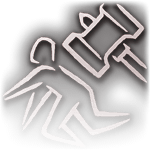
Greatclub, Maul, Warhammer
- When you hit a creature with an attack, you can attempt to knock the target down.
- The target must make a Strength saving throw. On a failed save, you knock the target prone.
Cleave
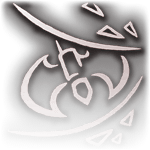
Battleaxe, Dwarven Urgrosh, Greataxe, Orc Double Axe
When you make an attack, you can attempt to hit multiple enemies at once.
Choose three 5-foot cubes within reach. Each cube must have at least one face adjacent to the face of another cube. You can make an attack roll against each creature occupying those spaces.
Concussive Smash
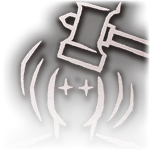
Club, Flail, Gnome Hooked Hammer, Maul, Sling, Warhammer
When you hit a creature with an attack, you can attempt to throw off the creature's balance.
The target must make a Constitution saving throw. On a failed save, attacks against the creature have advantage until the start of your next turn.
Crippling Strike

Morningstar, Pike, Trident, War Pick
When you hit a creature with an attack, you can attempt to stop the target in its tracks.
The target must make a Constitution saving throw. On a failed save, the target's speed is reduced to 0 until the end of its next turn and the target cannot take reactions until the start of your next turn.
Flourish
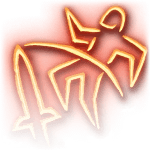
Claw Gauntlet, Rapier, Scimitar, Shortsword, Whip
- You can use a bonus action to fake an attack, catching your opponent off guard. You can also replace an attack with this weapon art, but you don't make an attack roll or deal damage.
- The next attack against the target has advantage.
Gargantuan Cleave

Halberd
When you make an attack, you can attempt to hit multiple enemies at once.
Choose five 5-foot cubes within reach. Each cube must have at least one face adjacent to the face of another cube. You can make an attack roll against each creature occupying those spaces.
Hamstring Shot

Blowgun, Longbow, Shortbow
When you hit with an attack, you can attempt to pin them.
The target must make a Constitution saving throw. On a failed save, the target's speed is reduced to 0 until the end of their next turn.
Heartstopper

Lance, Morningstar
You can use your action to attempt to sunder your opponent's ability to act.
The target must make a Constitution saving throw. On a failed save, the target becomes incapacitated until the start of your next turn.
Lacerate

Battleaxe, Claw Gauntlet, Double-Bladed Scimitar, Dwarven Urgrosh, Glaive, Greataxe, Greatscythe, Greatsword, Halberd, Light Hammer, Longsword, Orc Double Axe, Scimitar, Whip
- When you hit a creature with a weapon attack, you can make a deep cut that causes the target to bleed out.
- The target must make a Constitution saving throw. On a failed save the target bleeds, taking damage at the start of each of its turns equal to twice your proficiency bonus. Constructs, undead, and other creatures without blood cannot bleed.
The target or another creature can use an action to stop the bleeding. If the target gains hit points, the bleeding stops.
Mobile Shot
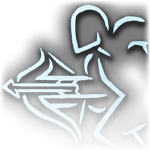
Hand Crossbow
- When you use your action to Dash or Disengage, you can use a bonus action to make one attack using this weapon.
Piercing Strike
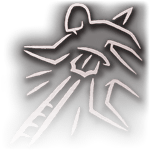
Blowgun, Dagger, Dart, Hand Crossbow, Heavy Crossbow, Lance, Longbow, Net, Pike, Rapier, Repeating Crossbow, Shortsword, Trident, War Pick
- When you hit a creature with a weapon attack, you can make a penetrating attack that causes the target to suffer additional damage from other attacks for a short time.
- The target must make a Constitution saving throw. On a failed save, the target takes extra damage from attacks equal to your proficiency modifier until the start of your next turn.
Pommel Strike
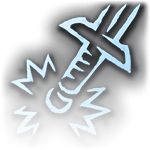
Sickle, Greatsword, Longsword, Scimitar, Shortsword
- You can use a bonus action to daze your opponent. You can also replace an attack with this weapon art, but you don't make an attack roll or deal damage.
- The target must make a Constitution saving throw. On a failed save, the target receives a penalty to their AC equal to your Proficiency Bonus until the start of your next turn.
Precise Shot

Blowgun, Hand Crossbow, Heavy Crossbow, Light Crossbow, Repeating Crossbow
- When you make your first attack on your turn, you can decide to focus on making your attacks more accurate.
- You can use this weapon art only if you haven't moved during this turn, and after you use the weapon art, your speed is 0 until the end of the current turn.
- You add twice your proficiency bonus to ranged attack rolls made with this weapon made during this turn.
Prepare
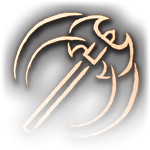
Battleaxe, Glaive, Greataxe, Greatscythe, Halberd, Longbow
- When you make your first attack on your turn, you can decide to focus on making your attacks more deadly.
- You can use this weapon art only if you haven't moved during this turn, and after you use the weapon art, your speed is 0 until the end of the current turn.
- Your attacks with this weapon deal additional damage equal to your proficiency bonus for the rest of this turn.
Rapidfire Shot
_action_icon_baldurs_gate3_guide_150px.png)
Repeating Crossbow
- When you make your first attack on your turn, you can decide to focus on overwhelming your target with volume of fire.
- You can use this weapon art only if you haven't moved during this turn, and after you use the weapon art, your speed is 0 until the end of the current turn.
- You can make one additional weapon attack with this weapon as part of that action this turn.
Riposte
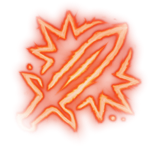
Double-Bladed Scimitar, Glaive, Greatsword, Longsword, Rapier
- When a creature misses you with a melee attack, you can use your reaction and make a melee weapon attack against the creature.
This attack counts as an opportunity attack.
Rush Attack
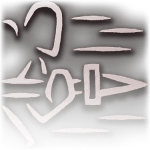
Lance, Pike, Spear, Trident
- When you take the attack action, you can move up to 10 feet before making an attack.
- If you move at least 10 feet in a straight line immediately before making this attack, you gain a +2 bonus to the attack roll.
Shattering Strike

Flail, Mace, Morningstar
- When you hit a creature with a weapon attack, you can dull their reactions.
- The target must make a Constitution saving throw. On a failed save, the target cannot take reactions and has disadvantage on Dexterity saving throws until the start of your next turn.
Topple
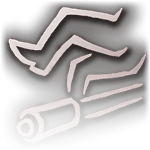
Flail, Gnome Hooked Hammer, Greatscythe, Net, Quarterstaff, Whip
- You can use a bonus action to trip your opponent. You can also replace an attack with this weapon art, but you don't make an attack roll or deal damage.
- The target must make a Dexterity saving throw. On a failed save, you knock the target prone.
Weakening Strike
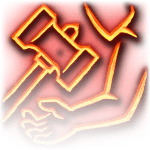
Light Hammer, Maul, War Pick, Warhammer
- When you hit a creature with a weapon attack, you can impair their strength.
- The target must make a Constitution saving throw. On a failed save, the target cannot take reactions and Strength saving throws until the start of your next turn.
Weapons
Your class grants proficiency in certain weapons, reflecting both the class's focus and the tools you are most likely to use. Whether you favor a longsword or a longbow, your weapon and your ability to wield it effectively can mean the difference between life and death while adventuring.
The Weapons table shows the most common weapons used in the worlds of D&D, their price and weight, the damage they deal when they hit, and any special properties they possess. Every weapon is classified as either melee or ranged. A melee weapon is used to attack a target within 5 feet of you, whereas a ranged weapon is used to attack a target at a distance.
Loadouts
The vast variance inherent to battle means that a single weapon may not be ideal in every situation. To remedy this, a character can prepare two weapon loadouts. A character can designate up to two weapons or shields they are proficient with as part of a loadout.
You can draw or stow two weapons or shields when you would normally be able to draw or stow only one, as long as they are part of the same loadout (such as drawing a longsword and equipping a shield). You can also swap between a loadout you are currently wielding and a second loadout if you aren't currently wielding any other items (Such as stowing a maul and drawing two battleaxes)
When you gain the extra attack feature, you can prepare an additional loadout.
Simple Melee Weapons Table
| Name | Cost | Damage | Weight | Properties | Weapon Arts |
|---|---|---|---|---|---|
| Club | 1 sp | 1d4 bludgeoning | 2 lb. | Light | Concussive Smash |
| Dagger | 2 gp | 1d4 piercing | 1 lb. | Finesse, light, thrown (20/60) | Piercing Strike |
| Greatclub | 2 sp | 1d8 bludgeoning | 10 lb. | Two-handed | Backbreaker |
| Handaxe | 5 gp | 1d6 slashing | 2 lb. | Light, thrown (20/60) | Lacerate |
| Javelin | 5 sp | 1d6 piercing | 2 lb. | Thrown (30/120) | Mobile Shot |
| Light Hammer | 2 gp | 1d4 bludgeoning | 2 lb. | Light, thrown (20/60) | weakening Strike |
| Mace | 5 gp | 1d6 bludgeoning | 4 lb. | — | Shattering strike |
| Martial Arts | — | — | — | Special | Concussive smash, prepare, and choose one between riposte, shattering strike, or weakening strike. |
| Quarterstaff | 2 sp | 1d6 bludgeoning | 4 lb. | Versatile (1d8) | Topple |
| Sickle | 1 gp | 1d4 Slashing | 2 lb. | Light | Pommel strike |
| Scythe | 2 gp | 1d6 | 4 lb. | Heavy, reach, two-handed | Lacerate |
| Spear | 1 gp | 1d6 piercing | 3 lb. | Thrown (20/60), versatile (1d8) | Rush Attack |
Simple Ranged Weapons Table
| Name | Cost | Damage | Weight | Properties | Weapon Arts |
|---|---|---|---|---|---|
| Dart | 5 cp | 1d4 piercing | 1/4 lb. | Finesse, light, thrown (20/60), | Piercing Strike |
| Light Crossbow | 25 gp | 1d8 piercing | 5 lb. | Ammunition (80/320), loading, two-handed | Precise Shot |
| Shortbow | 25 gp | 1d6 piercing | 2 lb. | Ammunition (80/320), two-handed | Hamstring Shot |
| Sling | 1 sp | 1d4 bludgeoning | — | Ammunition (30/120), light | Concussive Smash |
Martial Melee Weapons Table
| Name | Cost | Damage | Weight | Properties | Weapon Arts |
|---|---|---|---|---|---|
| Battleaxe | 10 gp | 1d8 slashing | 4 lb. | Versatile (1d10) | Cleave, lacerate, prepare |
| Claw Gauntlet | 25 gp | 1d4 Slashing | 1 lb. | Finesse, light, special | Flourish, lacerate |
| Flail | 10 gp | 1d8 bludgeoning | 2 lb. | Versatile (1d10), wrapping | Concussive smash, topple, shattering strike |
| Double-Bladed Scimitar | 100 gp | 2d4 slashing | 6 lb. | Double-weapon (1d4 slashing), two-handed | Lacerate, riposte |
| Dwarven Urgrosh | 100 gp | 1d8 slashing | 8 lb. | Double-weapon (1d4 piercing) heavy, two-handed | Cleave, lacerate |
| Glaive | 20 gp | 1d10 slashing | 6 lb. | Heavy, reach, two-handed | Lacerate, prepare, riposte |
| Gnome Hooked Hammer | 100 gp | 1d6 bludgeoning | 6 lb. | Double-weapon (1d4 piercing), two-handed | Concussive smash, topple |
| Greataxe | 30 gp | 1d12 slashing | 7 lb. | Heavy, two-handed | Cleave, lacerate, prepare |
| Greatscythe | 20 gp | 2d4 slashing | 6 lb. | Heavy, reach, two-handed | Lacerate, prepare, topple |
| Greatsword | 50 gp | 2d6 slashing | 6 lb. | Heavy, two-handed | Lacerate, pommel strike, riposte |
| Halberd | 20 gp | 1d10 slashing | 6 lb. | Heavy, reach, two-handed | Gargantuan cleave, lacerate, prepare |
| Lance | 10 gp | 1d12 piercing | 6 lb. | Reach, special | Heartstopper, piercing strike, rush attack |
| Longsword | 15 gp | 1d8 slashing | 3 lb. | Versatile (1d10) | Lacerate, pommel strike, riposte |
| Maul | 10 gp | 2d6 bludgeoning | 10 lb. | Heavy, two-handed | Backbreaker, concussive smash, weakening strike |
| Morningstar | 15 gp | 1d8 piercing | 4 lb. | — | Heartstopper, shattering strike, crippling strike |
| Orc Double Axe | 130 gp | 1d8 slashing | 10 lb. | Double-weapon (1d4 slashing), heavy, two-handed | Lacerate, prepare |
| Pike | 20 gp | 1d10 piercing | 18 lb. | Heavy, reach, two-handed | Crippling strike, piercing strike, rush attack |
| Rapier | 25 gp | 1d8 slashing | 3 lb. | Finesse | Flourish, piercing strike, riposte |
| Scimitar | 25 gp | 1d6 slashing | 3 lb. | Finesse, light | Flourish, lacerate, pommel strike |
| Shortsword | 10 gp | 1d6 piercing | 2 lb. | Finesse, light | Flourish, piercing strike, pommel strike |
| Trident | 5 gp | 1d6 piercing | 4 lb. | Thrown (range 20/60), versatile (1d8) | Crippling strike, piercing strike, rush attack |
| War Pick | 5 gp | 1d8 piercing | 4 lb. | — | Crippling strike, piercing strike, weakening strike |
| Warhammer | 15 gp | 1d8 bludgeoning | 2 lb. | Versatile (1d10) | Backbreaker, concussive smash, weakening strike |
| Whip | 2 gp | 1d4 slashing | 3 lb. | Finesse, reach, Wrapping | Flourish, , topple |
Martial Ranged Weapons Table
| Name | Cost | Damage | Weight | Properties | Weapon Arts |
|---|---|---|---|---|---|
| Blowgun | 10 gp | 1d4 piercing | 1 lb. | Ammunition (25/100) | Hamstring shot, piercing strike, precise shot |
| Hand Crossbow | 75 gp | 1d6 piercing | 3 lb. | Ammunition (30/120), light, loading | Mobile shot, piercing strike, precise shot |
| Heavy Crossbow | 50 gp | 1d10 piercing | 18 lb. | Ammunition (100/400), heavy, loading, two-handed | piercing strike, precise shot |
| Longbow | 50 gp | 1d8 piercing | 2 lb. | Ammunition (150/600), heavy (1d8), two-handed | Hamstring shot, piercing strike, prepare |
| Net | 1 gp | — | 3 lb. | Special, thrown (range 5/15), wrapping | Flourish, topple |
| Repeating Crossbow | 150 gp | 1d8 piercing | 12 lb. | Ammunition (80/320), heavy, loading, special, two-handed | Piercing strike, precise shot, rapidfire shot |
Weapon Properties
Ammunition
You can use a weapon that has the ammunition property to make a ranged attack only if you have ammunition to fire from the weapon. Each time you attack with the weapon, you expend one piece of ammunition. Drawing the ammunition from a quiver, case, or other container is part of the attack (you need a free hand to load a one-handed weapon). At the end of the battle, you can recover half your expended ammunition by taking a minute to search the battlefield.
Double-weapon
If you attack with a double-weapon as part of the Attack action on your turn, you can use a bonus action immediately after to make a melee attack with it. A damage value in parentheses appears with the property-the damage and type when the weapon is used to make a bonus action melee attack.
Finesse
When making an attack with a finesse weapon, you use your choice of your Strength or Dexterity modifier for the attack and damage rolls. You must use the same modifier for both rolls.
Heavy
Creatures that have less than 12 Strength have disadvantage on attack rolls with heavy weapons, small and tiny creatures alls have disadvantage.
Light
A light weapon is small and easy to handle, making it ideal for use when fighting with two weapons.
Loading
Because of the time required to load this weapon, you must use 1 attack or a bonus action to reload before you can attack with this weapon again. You must have one free hand to reload a weapon.
Range
A weapon that can be used to make a ranged attack has a range shown in parentheses after the ammunition or thrown property. The range lists two numbers. The first is the weapon's normal range in feet, and the second indicates the weapon's long range. When attacking a target beyond normal range, you have disadvantage on the attack roll. You can't attack a target beyond the weapon's long range.
Reach
This weapon adds 5 feet to your reach when you attack with it. This property also determines your reach for opportunity attacks with a reach weapon.
Special
A weapon with the special property has unusual rules governing its use, explained in the weapon's description (see "Special Weapons" later in this section).
Thrown
If a weapon has the thrown property, you can throw the weapon to make a ranged attack. If the weapon is a melee weapon, you use the same ability modifier for that attack roll and damage roll that you would use for a melee attack with the weapon. For example, if you throw a handaxe, you use your Strength, but if you throw a dagger, you can use either your Strength or your Dexterity, since the dagger has the finesse property.
Two-handed
This weapon requires two hands to use. This property is relevant only when you attack with the weapon, not when you simply hold it.
Versatile
This weapon can be used with one or two hands. A damage value in parentheses appears with the property-the damage when the weapon is used with two hands to make a melee attack.
Wrapping
These weapons wrap around an enemy's shield, you ignore the AC bonus granted by shields.
Special Weapons:
Lance
You have disadvantage when you use a lance to attack a target within 5 feet of you. Also, a lance requires two hands to wield when you aren't mounted.
Net
A Large or smaller creature hit by a net is restrained until it is freed. A net has no effect on creatures that are formless, or creatures that are Huge or larger. A creature can use its action to make a DC 10 Strength check, freeing itself or another creature within its reach on a success. Dealing 5 slashing damage to the net (AC 10) also frees the creature without harming it, ending the effect and destroying the net. When you use an action, bonus action, or reaction to attack with a net, you can make only one attack regardless of the number of attacks you can normally make.
Repeating Crossbow
This crossbow is fitted with a cartridge that can hold up to six crossbow bolts. It automatically reloads after firing until the cartridge runs out of ammunition.
Claw Gauntlet
A claw gauntlet is a weapon that attaches to your hand and wrist, becoming inseparable from you as long as you're wielding it. It takes an action to don or doff this weapon. Your hands are considered empty and can be used to interact with objects or cast a spell unhindered, but you can only attack with the claw gauntlet while you aren't holding anything in the equipped hand.
Fighting Styles
Blessed Warrior
- You learn two cantrips of your choice from the cleric spell list. They count as paladin spells for you, and Charisma is your spellcasting ability for them. Whenever you gain a level in this class, you can replace one of these cantrips with another cantrip from the cleric spell list.
Blind Fighting
- You have blindsight with a range of 10 feet. Within that range, you can effectively see anything that isn't behind total cover, even if you're blinded or in darkness. Moreover, you can see an invisible creature within that range, unless the creature successfully hides from you.
Danger-Close Archery
- You gain a +1 bonus to attack and damage rolls you make with ranged weapons against targets within 25 feet of you.
- When making a ranged attack while you are within 5 feet of a hostile creature, you do not have disadvantage on the attack roll.
- Your ranged attacks ignore half cover and three-quarters cover against targets within 25 feet of you.
Defense
- While you are wearing armor, you gain a +1 bonus to AC.
Druidic Warrior
- You learn two cantrips of your choice from the druid spell list. They count as ranger spells for you, and Wisdom is your spellcasting ability for them. Whenever you gain a level in this class, you can replace one of these cantrips with another cantrip from the druid spell list.
Dueling
- When you are wielding a melee weapon in one hand and no other weapons or shields, you gain a bonus to damage rolls equal to your proficiency bonus with that weapon.
Great Weapon Fighting
- When you roll a 1 or 2 on a damage die for an attack you make with a melee weapon that you are wielding with two hands, you can reroll the die and must use the new roll, even if the new roll is a 1 or a 2. The weapon must have the two-handed or versatile property for you to gain this benefit.
- When you make an attack you make with a melee weapon that you are wielding with two hands, you can add half your proficiency bonus (rounded down) to the damage rolls. The weapon must have the two-handed or versatile property for you to gain this benefit.
Precise Archery
- You gain a +2 bonus to attack rolls you make with ranged weapons against creature at least 30 feet away from you.
- Attacking at long range doesn't impose disadvantage on your ranged weapon attack rolls.
- Your ranged weapon attacks ignore half cover and three-quarters cover.
Protection
- When a creature you can see attacks a target other than you that is within 5 feet of you, you can use your reaction to impose disadvantage on the attack roll. You must be wielding a shield.
- When a creature you can see hits a target, other than you, within reach of you with an attack, you can use your reaction to reduce the damage the target takes by 1d10 + your proficiency bonus (to a minimum of 0 damage). You must be wielding a shield or a simple or martial weapon to use this reaction.
Superior Technique
- You learn one maneuver of your choice from among those available to the Battle Master archetype. If a maneuver you use requires your target to make a saving throw to resist the maneuver's effects, the saving throw DC equals 8 + your proficiency bonus + your Strength or Dexterity modifier (your choice).
- You gain one superiority die, which is a d6 (this die is added to any superiority dice you have from another source). This die is used to fuel your maneuvers. A superiority die is expended when you use it. You regain your expended superiority dice when you finish a short or long rest.
Thrown Weapon Fighting
- You can draw a weapon that has the thrown property as part of the attack you make with the weapon.
- Attacking at long range doesn't impose disadvantage on your thrown weapon attack rolls.
- In addition, when you hit with a ranged attack using a thrown weapon, you gain a bonus to damage rolls equal to your proficiency bonus with that weapon.
Two-Weapon Fighting
- When you engage in two-weapon fighting, you can add your ability modifier to the damage of the bonus action attack.
Unarmed Fighting
- Your unarmed strikes can deal bludgeoning damage equal to 1d6 + your Strength modifier on a hit. If you aren't wielding any weapons or a shield when you make the attack roll, the d6 becomes a d8.
- At the start of each of your turns, you can deal 1d4 bludgeoning damage to one creature grappled by you.
- You can use the Concussive Smash weapon art with unarmed strikes.
Weighted Archery
- When you make an attack with Darts, Longbows, Shortbows, or Slings, you can add your Strength modifier to damage rolls for those attacks in addition to your Dexterity.
- Your ranged attacks with these weapons ignore half cover and three-quarters cover.
Weapon Feats
Crossbow Expert
Thanks to extensive practice with the crossbow, you gain the following benefits:
- You ignore the loading quality of crossbows with which you are proficient.
- A hand crossbow has the Rapidfire Shot weapon art when you wield it.
Centaur Weapon Training
Prerequisite: Centaur You've trained in the weapons of your ancestors, you gain the following benefits:
- While you are wielding a Longsword in one hand, you deal damage as if you were wielding it in two hands.
- You ignore the special quality of Lances you wield.
Dual Wielder.
You master fighting with heavier weapons in each hand, gaining the following benefits:
- You gain a +1 bonus to AC while you are wielding a separate melee weapon in each hand.
- You can use two-weapon fighting even when the one-handed melee weapons you are wielding aren't light.
- You can draw or stow two one-handed weapons when you would normally be able to draw or stow only one.
Dwarven Weapon Training
Prerequisite: Dwarf
You've trained in the weapons of your ancestors, you gain the following benefits:
- While you are wielding a Warhammer or Battleaxe in one hand, you deal damage as if you were wielding them in two hands.
- A dwarven urgrosh has the Shattering Strike weapon art when you wield it.
- While you are holding a dwarven urgrosh with two hands, you gain a +1 bonus to Armor Class.
Elvish Weapon Training
Prerequisite: Elf
You are descended from a master of the double-bladed scimitar, and some of that mastery has passed on to you. You gain the following benefits:
- Shortbows and longbows have the Rapidfire Shot weapon art when you wield it.
- A double-bladed scimitar has the finesse property and Flourish weapon art when you wield it.
- When you make an opportunity attack with a weapon, you have advantage on the attack roll.
Genasi Weapon Training
Prerequisite: Genasi
You've trained in the weapons of your ancestors, you gain the following benefits:
- You can cast Enlarge/Reduce, targeting yourself, a number of times equal to your proficiency bonus, regaining all expended uses when you finish a long rest. You can also cast the Detect Magic spell as a ritual.
- You also gain one of the following based on your subrace:
Air: A Scimitar has the Riposte weapon art when you wield it.
Earth: A Maul has the Heartstopper weapon art when you wield it.
Fire: A Scimitar has the Cleave weapon art when you wield it
Water: While you wield a Trident in one hand, it deals damage as if you were wielding it in two hands.
Gnomish Weapon Training
Prerequisite: Gnome
You've trained in the weapons of your ancestors, you gain the following benefits:
- You ignore the heavy property of Heavy Crossbows and Repeating Crossbows
- A gnome hooked hammer has the finesse property and Flourish weapon art when you wield it.
- When you use the Topple weapon art using the gnome hooked hammer against a medium or larger creature, it has disadvantage on its dexterity saving throw.
Goblin Weapon Training
Prerequisite: Goblin
You've trained in the weapons of your ancestors, you gain the following benefits:
- A scimitar has the Crippling Strike weapon art when you wield it.
- A shortbow has the Rapidfire Shot weapon art when you wield it.
Great Weapon Master
You've learned to put the weight of a weapon to your advantage, letting its momentum empower your strikes. You gain the following benefits:
- On your turn, when you use the attack action and score a critical hit with a melee weapon or reduce a creature to 0 hit points with one, you can make one melee weapon attack as part of that same action.
- Your heavy weapon attacks score a critical hit on a roll of 19 or 20. If you have a feature that already let's you score critical hits on a 19, this feat increases the range by 1.
For example a level 3 Champion would score a critical hit on a roll of 18-20 and a level 15 Champion would score a critical hit on a roll of 17-20.
Halfling Weapon Training
Prerequisite: Halfling
You've trained in the weapons of your ancestors, you gain the following benefits:
- Light weapons have the Mobile Shot weapon art when you wield them.
- A Sling deals an additional 1d4 damage and has the Rapidfire Shot weapon art when you wield it.
- Thrown weapons gain the Precise Shot weapon art when you wield them.
Orcish Weapon Training
Prerequisite: Orc
You've trained in the weapons of your ancestors. You gain the following benefits:
- When you wield a battleaxe or spear in one hand, you deal damage as if you were holding it in two hands.
- A greataxe or orc double axe has the Gargantuan Cleave weapon art when you wield it.
- You deal additional damage equal to your proficiency bonus when you hit the same target twice on your turn with an orc double axe.
Polearm Master
You can keep your enemies at bay with reach weapons. You gain the following benefits:
- When you take the Attack action and attack with only a glaive, greatscythe, halberd, quarterstaff, spear, or trident, you can use a bonus action to make a melee attack with the opposite end of the weapon; this attack uses the same ability modifier as the primary attack. The weapon's damage die for this attack is a d4, and the attack deals bludgeoning damage.
- While you are wielding a glaive, greatscythe, halberd, pike, quarterstaff, scythe, spear, or Trident, other creatures provoke an opportunity attack from you when they enter the reach you have with that weapon.
Shield Master
You use shields not just for protection but also for offense. You gain proficiency with shields if you don't already have it and you gain the following benefits while you are wielding a shield:
- You can use your shield to perform the pommel strike and topple weapon arts, also you can use the riposte weapon art with a weapon while wielding a shield.
- If you aren't incapacitated, you can add your shield's AC bonus to any Dexterity saving throw you make against a spell or other harmful effect that targets only you.
- If you are subjected to an effect that allows you to make a Dexterity saving throw to take only half damage, you can use your reaction to take no damage if you succeed on the saving throw, interposing your shield between yourself and the source of the effect.
Swift Striker
You master fighting with light weapons in each hand, gaining the following benefits:
- You gain a +1 bonus to AC while you are wielding a separate light melee weapon in each hand.
- When you use a bonus action to attack using two-weapon fighting while only wielding two light weapons, you can make a second attack as part of the bonus action attack.
- You can draw or stow two one-handed weapons when you would normally be able to draw or stow only one.
Tavern Brawler
Accustomed to rough-and-tumble fighting using whatever weapons happen to be at hand, you gain the following benefits:
- You are proficient with improvised weapons.
- Your unarmed strike uses a d4 for damage.
- When you hit a creature with an unarmed strike or an improvised weapon on your turn, you can use a bonus action to attempt to grapple the target.
- You can use the Crippling Strike weapon art with unarmed strikes and improvised weapons.
Tiger Claw Style
Prerequisite: Monk
By following the teachings of the tiger school, you have honed the art of fighting with the ferocity of beasts.
- A claw gauntlet has the Rush Attack weapon art when you wield it.
- While you're wielding two claw gauntlets and both hands are free, you can attack an additional time as part of the same action.
- While wielding two claw gauntlets, you gain a +1 bonus to Armor Class.
Weapon Master
You have mastered the use of weapon arts, making them harder to resist, gaining the following benefits:
- The DC of your weapon arts is increased by 2.
- As a bonus action, you can regain one expended weapon art use, but you can't do so again until you finish a short or long rest.
Weapon Training
You have practiced extensively with a variety of weapons, gaining the following benefits:
- Increase one ability score of your choice by 1, to a maximum of 20.
- You gain proficiency with four weapons of your choice. Each one must be a simple or a martial weapon.
Armor and Shields
Light Armor
| Name | Cost | Armor Class | Weight | Strength | Stealth | Hardness | Hit Points |
|---|---|---|---|---|---|---|---|
| Padded | 5 gp | 10 + Dex modifier + proficiency bonus | 8 lb. | — | Disadvantage | — | Your level + your proficiency bonus |
| Leather | 10 gp | 10 + Dex modifier + proficiency bonus | 10 lb. | — | — | — | Your level + your proficiency bonus |
| Studded Leather | 45 gp | 10 + Dex modifier + proficiency bonus | 13 lb. | — | — | 3 | Your level + your proficiency bonus + 3 |
Medium Armor
| Name | Cost | Armor Class | Weight | Strength | Stealth | Hardness | Hit Points |
|---|---|---|---|---|---|---|---|
| Hide | 10 gp | 10 + Dex modifier (max 2) + proficiency bonus | 12 lb. | — | — | — | Your level + twice your proficiency bonus |
| Chain Shirt | 50 gp | 10 + Dex modifier (max 2) + proficiency bonus | 20 lb. | — | — | 3 | Your level + twice your proficiency bonus + 3 |
| Scale Mail | 50 gp | 10 + Dex modifier (max 2) + proficiency bonus | 45 lb. | — | Disadvantage | 6 | Your level + twice your proficiency bonus + 6 |
| Breast Plate | 400 gp | 10 + Dex modifier (max 2) + proficiency bonus | 20 lb. | — | — | 6 | Your level + twice your proficiency bonus + 6 |
| Half Plate | 750 gp | 10 + Dex modifier (max 2) + proficiency bonus | 45 lb. | — | Disadvantage | 9 | Your level + twice your proficiency bonus + 9 |
Heavy Armor
| Name | Cost | Armor Class | Weight | Strength | Stealth | Hardness | Hit Points |
|---|---|---|---|---|---|---|---|
| Ring Mail | 30 gp | 10 + proficiency bonus | 40 lb. | — | Disadvantage | 3 | Twice your level + twice your proficiency bonus |
| Chain Mail | 75 gp | 10 + proficiency bonus | 55 lb. | Str 13 | Disadvantage | 6 | Twice your level + twice your proficiency bonus + 5 |
| Splint | 200 gp | 10 + proficiency bonus | 60 lb. | Str 15 | Disadvantage | 9 | Twice your level + twice your proficiency bonus + 10 |
| Plate | 1,500 gp | 10 + proficiency bonus | 65 lb. | Str 17 | Disadvantage | 12 | Twice your level + twice your proficiency bonus + 15 |
Shields
| Name | Cost | Armor Class | Weight | Cover from ranged attacks | Stealth | Weapon Arts |
|---|---|---|---|---|---|---|
| Buckler | 5 gp | +0 | 2 lb. | — | — | Bash, Parry, Withdraw |
| Heater | 10 gp | +1 | 4 lb. | — | — | Bash, Parry, Withdraw |
| Kite | 20 gp | +1 | 8 lb. | half cover | Disadvantage | Block, Brace, Withdraw |
| Banded | 20 gp | +2 | 8 lb. | — | Disadvantage | Block, Brace, Withdraw |
| Pavise | 50 gp | +3 | 12 lb. | three-quarters cover | Disadvantage | Block, Brace, Withdraw |
Armor
Hardness
Armor reduces incoming damage based on its hardness. The armor's hardness lessens by 1 with each hit the armor receives until it is repaired.
Example: Plate Armor will reduce the first attack you receive by 12, the next attack by 11, and so on.
Studded Leather on the other hand will reduce the first attack you receive by 3, the next by 2, and the last attack by 1.
After that the armor will still absorb damage if it still has hit points, but it will no longer reduce the damage. Armor that runs out of hit points will still reduce incoming damage if it still has hardness remaining.
Magic Armor
An armor's AC bonus is increased by +1, 2, or 3 depending on the bonus. the hitpoints is increased by 10 times the bonus.
IE. A +2 Chain Mail will have an AC of 12 + your proficiency bonus and +20 hitpoints.
Special
Buckler Shield
You can use a bonus action to don and doff this shield instead of an action.
Pavise Shield
You can use an action to place the shield down and plant it on the ground, providing a temporary defense.
(You can use a bonus action instead if you are proficient with this shield)
A planted pavise shield can provide full cover to one medium or smaller creature, or a larger creature if the shield is sized for a larger creature.
Your attacks have disadvantage while you have this shield equipped.
Combat Skills
Bash
Buckler, Heater
You can use a bonus action to try to shove a creature within 5 feet of you with your shield.
Block
Banded, Kite, Pavise
If you are subjected to an effect that allows you to make a Dexterity saving throw to take only half damage, you can use your reaction to take no damage if you succeed on the saving throw, interposing your shield between yourself and the source of the effect.
Brace
Banded, Kite, Pavise
When you take damage from an attack, you can use your reaction to reduce the damage by your level + your proficiency bonus + twice the shield's AC bonus.
Parry
Buckler, Heater
When another creature hits you with a melee attack, you can use your reaction to add +5 to your AC for that attack, potentially causing the attack to miss you. If the attack misses, you can make one attack as part of that reaction.
Withdraw
Banded, Buckler, Heater, Kite, Pavise
You can take the Disengage action as a bonus action.